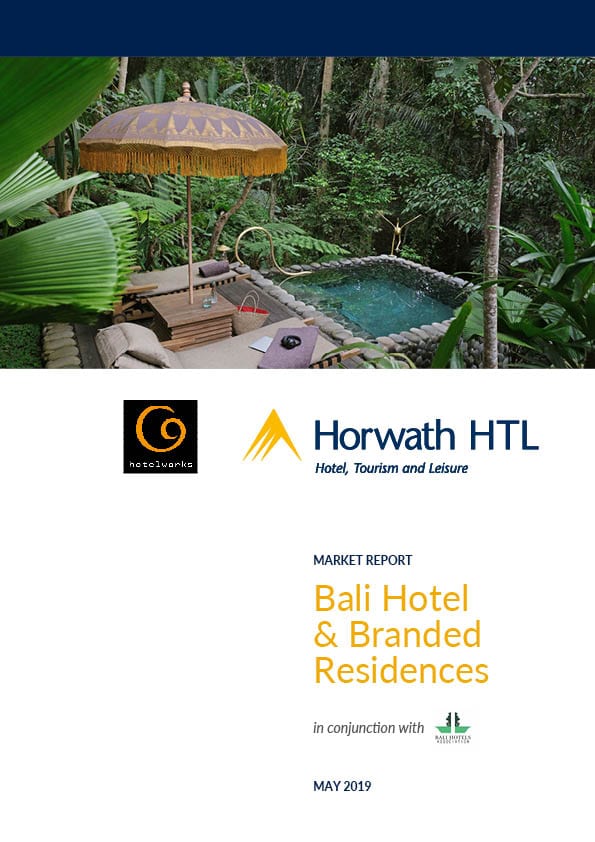
Market Report
Bali Hotels & Branded Residences 2019
The Bali hotel and branded residences market experienced a tumultuous year in 2018, marked by natural disasters and regulatory changes. Despite these challenges, the market showed resilience, with notable growth in visitor arrivals and hotel performance metrics.
This report provides a detailed analysis of the market dynamics, visitor demographics, hotel performance, and future outlook.
Key Events and Market Impact
- Mount Agung Eruptions: The volcano erupted multiple times in 2018 and early 2019, causing temporary closures of Ngurah Rai Airport and affecting international arrivals.
- Lombok Earthquake: The 7.0-magnitude earthquake in August 2018, followed by significant aftershocks, impacted Bali’s tourism.
- Regulatory Crackdowns: The Balinese Provincial Government’s crackdown on unlicensed shops aimed at curbing fraudulent practices against Chinese tourists led to a decline in Chinese arrivals.
Visitor Arrivals
- Total Arrivals: International arrivals reached 6 million in 2018, a 6% year-over-year growth, though slower compared to previous years (16% in 2017 and 23% in 2016).
- Nationality Mix:
- Asia (Excluding ASEAN): 60% of total arrivals, with slight growth of 3%.
- ASEAN: Strong growth of 29%, driven by visa exemptions and affordable flights.
- Europe: 23% of total, with moderate growth from Russia (17%), UK (10%), and France (10%).
- Americas: 6% of total, with a 12% increase, particularly from the US (21%) and Mexico (24%).
Top Source Markets
- China: Despite a 2% decline, China remained the top source market with 1.36 million arrivals.
- Australia: The second largest market, with a 5% increase in arrivals.
- India: The fastest-growing market among the top five, with a compound annual growth rate of 30% since 2010.
- Philippines and US: Notable increases, with 52% and 21% growth, respectively.
Hotel Performance by Rate Segment
- Overall Performance:
- Occupancy: Increased to 72% in 2018 from 71% in 2017.
- ADR (IDR): Increased by 13% to 1,989,000.
- RevPAR (IDR): Increased by 16% to 1,438,000.
- ADR (USD): Increased by 4% to 136.
- RevPAR (USD): Increased by 7% to 99.
- Luxury Segment (>$350 USD):
- Occupancy: Increased to 58% from 57%.
- ADR (IDR): Increased by 9% to 7,465,000.
- RevPAR (IDR): Increased by 10% to 4,308,000.
- ADR (USD): Increased by 3% to 526.
- RevPAR (USD): Increased by 4% to 304.
- Upper Upscale Segment ($151 – $349 USD):
- Occupancy: Declined to 69% from 71%.
- ADR (IDR): Increased by 8% to 2,981,000.
- RevPAR (IDR): Increased by 5% to 2,059,000.
- ADR (USD): Increased by 1% to 209.
- RevPAR (USD): Decreased by 1% to 144.
- Upscale Segment ($101 – $150 USD):
- Occupancy: Declined to 72% from 73%.
- ADR (IDR): Increased by 5% to 1,781,000.
- RevPAR (IDR): Increased by 5% to 1,290,000.
- ADR (USD): Decreased by 1% to 125.
- RevPAR (USD): Decreased by 2% to 91.
- Midscale Segment ($50 – $101 USD):
- Occupancy: Increased to 75% from 71%.
- ADR (IDR): Increased by 26% to 1,158,000.
- RevPAR (IDR): Increased by 33% to 874,000.
- ADR (USD): Increased by 9% to 75.
- RevPAR (USD): Increased by 16% to 57.
Performance by Location
- Kuta/Tuban and Legian/Seminyak: Highest occupancy levels, with slight declines in ADR.
- Jimbaran/Uluwatu: Highest ADR growth of 8%.
- Ubud: Lowest occupancy levels, influenced by its location away from the airport and beach.
Future Supply
- Upcoming Hotels: 43 new hotels with approximately 7,000 rooms are expected to open within the next five years, primarily in the 3-star and 4-star categories.
- Hot Spots: West Bali (Canggu and Tabanan) and South Bali remain key areas for new developments.
Real Estate Market
- Buyer Profile: Predominantly domestic investors due to foreign ownership restrictions. Demand from foreign buyers, especially from Australia and western countries, is expected to grow slowly.
Market Dynamics:
- Condominiums/Apartments: Concentrated in midscale to upscale tiers.
- Villas: Mainly in the upscale to luxury tiers.
- Management Programs: Increasing preference for properties with rental management programs.
Download the report
For detailed charts, graphs, and further analysis, download the full report here





